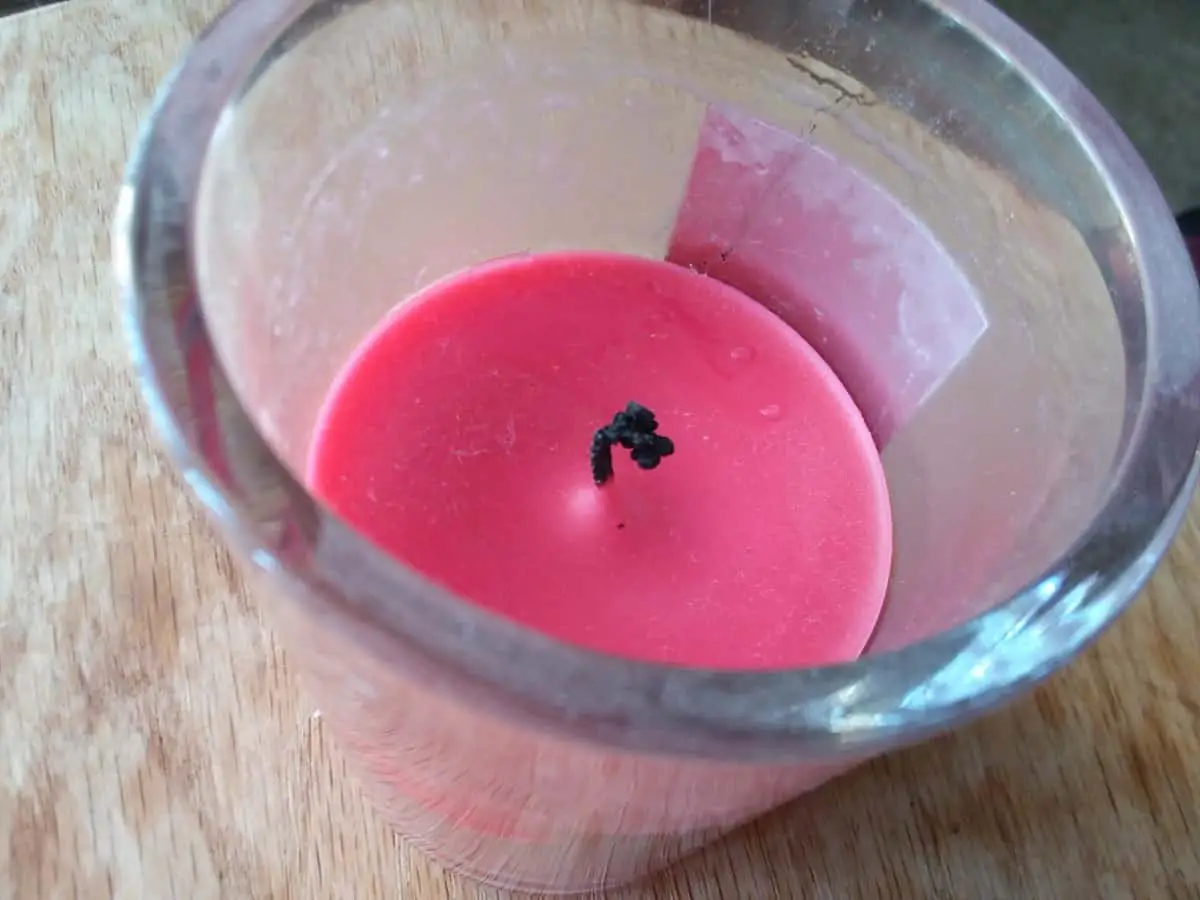It’s called a “mushroom” wick, but I don’t think it looks much like a mushroom.
While researching other posts and learning more about candles, I came across the term “mushrooming wick” or the description of when a “wick mushrooms.” I had never heard that terminology before and was not sure if I had wicks on my candles that were mushroomed.
So, I decided to investigate this further.
What is a mushrooming wick and how do you prevent or fix it? A “mushroom” wick occurs when the wax does not burn fast enough to keep up with the wick, which results in the wick absorbing the wax and creating a buildup of carbon particles on the wick. To fix a mushroom wick, trim the black “cap” off and bend or “curl” the tip of the wick. Using the correct wick, wax, and fragrances when creating a candle is vital to prevent mushrooming in the future.
The overabundance of the wax on the wick causes the incombustible material to build up creating a black “cap” or mushroom on the wick. This most commonly happens when the wick is not appropriately sized for the candle, usually when the wick is too big. An oversized wick causes more wax to be sent to the flame than it can handle; the flame can’t burn all that wax, so it causes this carbon buildup.
Creating a candle with a wick that does not mushroom includes a variety of factors. Although an improperly-sized wick is one, and probably the most common, explanation for a mushrooming wick, there are actually other possible reasons for the black cap, or carbon buildup, on your candle. Not only have I researched what causes a mushroom wick, but I also found out how to fix it and how to prevent it from the start.
What is a Mushroom Wick and What Causes It?
A mushroom wick results from a buildup of carbon particles on the wick, because the flame consumes more wax than it can burn. Mushrooming occurs when there is too much wax on the wick to be burned, which causes the partially-reduced molecules to build up on the end of the wick, creating the “black cap” or “mushroom wick” you see.
The particles are unable to reach the flame and combine with oxygen to complete the burning process. Therefore, this incompletely combusted material falls back onto the wick and builds up as a carbon cap on the end of the wick. Here are some common causes of a mushrooming wick:
Wick Size
One main cause of carbon buildup is when the wick is not properly sized for the candle. This most commonly occurs because the wick is too big for the candle.
An over-sized wick will provide more wax to the flame than it can handle. Or if the wrong type of wick, in general, is used from the start, the candle will most likely not burn properly/correctly and mushroom. A proper wick is going to provide the appropriately-sized burn pool for the width/diameter of the candle and is meant to create an appropriate flame height.
A large wick can also create a flame that is too large (tall) for the candle, which can cause other problems when burning the candle. If your flame is too large for the candle, that means there will be too much heat for the surface area of the candle.
Too much heat can cause the fragrance to break down too quickly before being dispersed, which means you will have a poor hot throw and can also cause sooting.
Wick Type
Not only does an incorrect wick size cause mushrooming, but an improper choice for the type of wick can create mushrooming, as well.
Zinc core wicks cause the wick to stand up straight when the candle is burning. Coreless wicks provide a controlled curling of the wick over time as it burns, which will help prevent mushrooming. Flat braided cotton wicks are considered “self-trimming” and will also help reduce mushrooming.
Burn Time
Another cause of mushrooming wicks is long burn time. If you burn your candle for more than 4 hours at a time, your wick may begin to mushroom, because carbon will start to collect on the wick.
Wick Length
When your wick isn’t kept trimmed or wasn’t trimmed before it was lit, it may mushroom. If the wick is too long to begin with (not trimmed properly), then you will most likely get a mushroom cap.
Wax vs. Dye/Scent
Wax vs. dye/scent is another major factor in mushrooming. Soy wax seems to be the type of wax with the reputation for mushrooming. However, any type of wax candle can mushroom. Again, the type of wick is the main culprit.
Heavy floral scents can also cause mushrooming due to the chemicals involved. The scent or dye can sometimes collect on the wick, which does not allow the flame to combust it completely and it will create a carbon buildup.
How to Fix a Mushroom Wick
Make sure you have the right size wick for your candle. If you are making your own candle, you have more control over this. However, if you buy your candles, you do not.
There are so many candle manufacturers that do not take the time or consideration to pick an appropriate-sized wick for their candles. They may be more concerned about appearance, scent, and aesthetics, than performance and functionality.
Therefore, if you are buying a candle from a store, it may not have the correct-sized wick and you may find that it mushrooms.
After you light the candle and it has burned for a while, take a look at the wick. Is it standing straight up or is it curled?
If the wick tip is bent slightly to the side, it will not form a carbon ball or “mushroom,” because hard as it may be to believe, the hottest part of the flame is actually the side. I know! This fact surprised me, too! Because I would think the center of the flame would be the hottest.
If the wick tip is standing straight up, you will most likely get a “mushroom cap,” because the tip of the wick is not in the hottest part of the flame (which, again, is the side of the flame).
If you do notice you have a “mushroomed” wick, with carbon buildup, you have two options. While it is burning, you could use a tool to curl the wick to get rid of the mushroom cap. The other option is to trim the wick when the candle is cooled and before you light it again.
If you choose to curl the wick with a tweezers or other tool while it is burning so that the carbon tip is toward the side of the flame, the carbon ball should get burned up. Once that is gone, the wick should burn properly after that.
If you notice the mushroom wick when the candle is not lit, make sure to trim the wick before you light it again. Then, you can bend the wick before you light it, so that it can combust properly when it is lit.
Remember: the hottest part of the flame is actually the side. You can usually tell when the wick is burning if it will mushroom based on what it looks like, whether it is standing straight up or bend over at an angle.
You do not want to light a mushroomed wick. If you do, it could cause the wick to crackle and pop, which will release soot into the air.
How to Prevent a Mushroom Wick
The best way to prevent a mushroom wick is to use the correct wick for the candle from the start. If the wick points straight up, it will not combust properly and will mushroom. The worst wicks that mushroom are zinc cores. The metal core keeps the wick standing up, which is what causes the wick to mushroom.
A good wick will curl while burning. This means the wick burn vs. wax evaporation rate is fairly equal to create the best candle experience.
Make sure you are testing your candles thoroughly to create the perfect manufacturing specs before you sell them. If you notice the flame is burning very brightly, this is indicative of a wick that is taking on more wax than it can burn, which means it will eventually mushroom.
Also, if the flame is too large and the wick is becoming too hot, it may start to mushroom and soot.
In order to identify any potential mushrooming habits when testing your candles, pay attention to the melt pool. If you notice a full melt pool forms rather quickly, your wick is probably too large and it will most likely eventually mushroom.
A general rule of thumb is that a full melt pool should form within the same number of hours as the diameter (or width) in inches. For example, if you have a 3-inch wide candle, it should take 3 hours for a full burn pool to develop. If you have a 3-inch wide candle and it is taking only 1 or 2 hours for the entire surface area of the candle to melt, then your wick is too big for the candle. Try a smaller sized wick.
Finding the right balance of fragrance will also be important in creating a candle that has limited mushroom potential. However, even a small amount of fragrance can cause mushrooming. A small number of fragrances will always cause mushrooming. The only advice here is time and experimentation.



